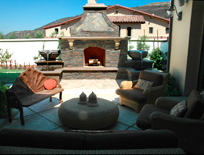Tuning the Sound of Falling Water

 In creating waterfalls, some watershapers don’t seem to realize is that you can precisely control the sound the falling water makes as it descends from level to another.
In creating waterfalls, some watershapers don’t seem to realize is that you can precisely control the sound the falling water makes as it descends from level to another.
My goal in paying attention to this detail is to take advantage of as many of the words we use to describe falling and flowing water as possible — from splashing, pouring, trickling and gushing to tumbling, sheeting, gurgling, dripping, spurting and crashing, among many others.
I do so because, through the years, I’ve found that the way water sounds can have a tremendously positive — or negative — influence on the success of a project.
Scenario: Several years ago, we designed and built a truly beautiful fire-and-water feature in a courtyard enclosed on three sides by the house itself, with the fourth opening onto a direct view of the neighbor’s property. For privacy’s sake, we added a fourth wall that included an outdoor fireplace.
We installed a pair of stone waterfalls flanking the fireplace — actually, simple scuppers flowing into catch basins. It was a great look, and we uplit both of the waterfalls so that the light from each danced on the ceilings inside. Just gorgeous!
The problem was, the waterfeatures sounded like nothing so much a two giants relieving themselves into oversized toilets. The monotony was awful, among the worst cases I’d ever heard. I couldn’t even look my clients in the eye — and even worse, I had no immediate idea of what to do to fix things.
We tried raising and lowering the water levels, but it just sounded like the giants were now urinating from different heights. Then we adjusted the flow, which simply made it sound as though the giants were doing their business with differing levels of urgency.
No matter what we tried, there simply was something about the acoustics of the space and the nature of these waterfeatures that made the courtyard sound like a very busy men’s room. It seems funny now, but at the time my clients were becoming increasingly impatient — and I genuinely didn’t know what to do.
Solution: Ultimately, we tried a completely different approach: We placed stainless steel mesh over the surface of the water, recessing the sheets in the square catch basins so they weren’t readily visible, and used them as diffusers to alter the way the water reached the surfaces of the basins.
It did the trick: What had been a horrible, monotonous droning sound was transformed into the beautifully soft music of falling rain — the best-sounding waterfeature we’ve ever made.
Talk about relief!
Lesson Learned: Sometimes, even great looks produce unanticipated results. You can’t know everything ahead of time, but with experience you figure out what works and how to develop solutions when things don’t turn out the way you want.
Scott Cohen is president and supervising designer of The Green Scene, an outdoor design and construction firm based in Northridge, Calif. He provides consultation for clients nationwide and gives seminars on designing landscapes, swimming pools and outdoor kitchens. For more information, go to www.greenscenelandscape.com.









